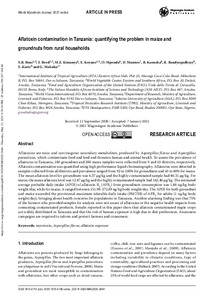| dc.contributor.author | Boni, S. |
| dc.contributor.author | Beed, F. |
| dc.contributor.author | Kimanya, M. |
| dc.contributor.author | Koyano, E. |
| dc.contributor.author | Mponda, O. |
| dc.contributor.author | Mamiro, D. |
| dc.contributor.author | Kaoneka, B. |
| dc.contributor.author | Bandyopadhyay, R. |
| dc.contributor.author | Korie, S. |
| dc.contributor.author | Mahuku, G. |
| dc.date.accessioned | 2021-06-17T11:20:31Z |
| dc.date.available | 2021-06-17T11:20:31Z |
| dc.date.issued | 2021 |
| dc.identifier.citation | Boni, S.B., Beed, F., Kimanya, M.E., Koyano, E., Mponda, O., Mamiro, D., ... & Mahuku, G. (2021). Aflatoxin contamination in Tanzania: quantifying the problem in maize and groundnuts from rural households. World Mycotoxin Journal, 1-12. |
| dc.identifier.issn | 1875-0710 |
| dc.identifier.uri | https://hdl.handle.net/20.500.12478/7133 |
| dc.description.abstract | Aflatoxins are toxic and carcinogenic secondary metabolites, produced by Aspergillus flavus and Aspergillus parasiticus, which contaminate food and feed and threaten human and animal health. To assess the prevalence of aflatoxins in Tanzania, 180 groundnut and 200 maize samples were collected from 9 and 10 districts, respectively. Aflatoxin contamination was quantified using high performance liquid chromatography. Aflatoxins were detected in samples collected from all districts and prevalence ranged from 92 to 100% for groundnuts and 10 to 80% for maize. The mean aflatoxin level for groundnuts was 6.37 μg/kg and the highly contaminated sample had 40.31 μg/kg. For maize, the mean aflatoxin level was 12.47 μg/kg and the highly contaminated sample had 162.40 μg/kg. The estimated average probable daily intake (APDI) of aflatoxin B1 (AFB1) from groundnuts consumption was 1.88 ng/kg body weight/day, while for maize, it ranged between 151.98-272.89 ng/kg body weight/day. The APDI for both groundnut and maize exceeded the provisional maximum tolerable daily intake (PMTDI) of AFB1 for adults (1 ng/kg body weight/day), bringing about health concerns for populations in Tanzania. Another alarming finding was that 75% of the farmers who provided samples for analysis were not aware of aflatoxins or the negative health impacts from consuming contaminated products. Results reported in this paper show that aflatoxin contaminated staple crops are widely distributed in Tanzania and that the risk of human exposure is high due to diet preferences. Awareness campaigns are required to inform and protect farmers and consumers. |
| dc.description.sponsorship | United States Agency for International Development |
| dc.description.sponsorship | Bill & Melinda Gates Foundation |
| dc.format.extent | 1-12 |
| dc.language.iso | en |
| dc.subject | Mycotoxins |
| dc.subject | Maize |
| dc.subject | Aflatoxins |
| dc.subject | Aspergillus Flavus |
| dc.subject | Tanzania |
| dc.subject | Grandnuts |
| dc.title | Aflatoxin contamination in Tanzania: quantifying the problem in maize and groundnuts from rural households |
| dc.type | Journal Article |
| cg.contributor.crp | Agriculture for Nutrition and Health |
| cg.contributor.crp | Maize |
| cg.contributor.crp | Roots, Tubers and Bananas |
| cg.contributor.affiliation | International Institute of Tropical Agriculture |
| cg.contributor.affiliation | World Agroforestry Centre |
| cg.contributor.affiliation | Food and Agriculture Organization of the United Nations |
| cg.contributor.affiliation | The Nelson Mandela African Institute of Science and Technology |
| cg.contributor.affiliation | World Vision International |
| cg.contributor.affiliation | Ministry of Agriculture, Livestock and Fisheries, Tanzania |
| cg.contributor.affiliation | Sokoine University of Agriculture |
| cg.coverage.region | Africa |
| cg.coverage.region | East Africa |
| cg.coverage.country | Tanzania |
| cg.coverage.hub | Eastern Africa Hub |
| cg.coverage.hub | Headquarters and Western Africa Hub |
| cg.researchtheme | Plant Production and Health |
| cg.identifier.bibtexciteid | BONI:2021 |
| cg.isijournal | ISI Journal |
| cg.authorship.types | CGIAR and developing country institute |
| cg.iitasubject | Aflatoxin |
| cg.iitasubject | Agronomy |
| cg.iitasubject | Disease Control |
| cg.iitasubject | Food Security |
| cg.iitasubject | Maize |
| cg.iitasubject | Plant Breeding |
| cg.iitasubject | Plant Diseases |
| cg.iitasubject | Plant Production |
| cg.journal | World Mycotoxin Journal |
| cg.notes | Published online: 28 Apr 2021 |
| cg.accessibilitystatus | Open Access |
| cg.reviewstatus | Peer Review |
| cg.usagerightslicense | Creative Commons Attribution 4.0 (CC BY 0.0) |
| cg.targetaudience | Scientists |
| cg.identifier.doi | https://dx.doi.org/10.3920/wmj2020.2646 |
| cg.iitaauthor.identifier | Ranajit Bandyopadhyay: 0000-0003-2422-4298 |
| cg.iitaauthor.identifier | George Mahuku: 0000-0001-8444-8651 |
| cg.futureupdate.description | volume number |
| cg.futureupdate.required | Yes |
| cg.futureupdate.duration | 3 Months |
| cg.contributor.acknowledgements | The authors would like to thank TFDA for aflatoxin analysis, SUA, TPRI and MA in Tanzania for attending the stakeholders’ inception workshop and helping with the survey and sample collection; IITA as a host and all other participants in the stakeholders’ inception workshop including Civil Education is the Solution for Poverty and Environmental Management (CESOPE) – all Tanzanian and Ohio State University – international institutions. This study was jointly funded by the USAID’s Feed the Future Africa Rising initiative and the Bill & Melinda Gates Foundation (OPP1007117) as part of the CGIAR Research Program on Agriculture for Nutrition and Health (A4NH). |

